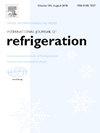Innovative photoacoustic instrument for fast and accurate detection and localization of R-134a leaks in refrigeration systems
IF 3.5
2区 工程技术
Q1 ENGINEERING, MECHANICAL
International Journal of Refrigeration-revue Internationale Du Froid
Pub Date : 2025-04-03
DOI:10.1016/j.ijrefrig.2025.04.003
引用次数: 0
Abstract
Refrigerant leaks are a common issue that can seriously impact both the performance of refrigeration systems and the environment. The need for reliable and sensitive leak detection has become increasingly critical due to regulatory bans on refrigerants with a high global warming potential. A new potential option for detecting possible leaks in refrigeration installations is the development of a highly sensitive photoacoustic (PA) instrument, which allows for more accurate, faster and easier detection of leakage points in refrigeration equipment than currently commercially available equipment. This article reports on the development of a highly sensitive photoacoustic instrument for the detection and localization of R-134a leaks to identify leaks at rates as low as 1.2 g/year in refrigeration systems. The developed system includes a quantum cascade laser that operates around 10.3 µm with a maximum output power of 84 mW. It features a stainless steel photoacoustic cell with two 40 mm resonator tubes, each with a 3.5 mm inner diameter. This setup ensures the accurate detection of R-134a refrigerant leaks by targeting specific absorption lines. The fast response time, wide dynamic concentration range, and high sensitivity of the PA instrument make it a promising tool for refrigerant leak detection. The paper also discusses spectral interference from other environmental and refrigerant gases, such as water vapor, carbon dioxide, ammonia, methane, propane, and R-32. A detailed finite element model has been developed and implemented in COMSOL Multiphysics 6.2. The simulation results matched the experimental data, validating the accuracy of the PA system.
创新的光声仪器,用于快速准确地检测和定位制冷系统中的R-134a泄漏
制冷剂泄漏是一个常见的问题,它会严重影响制冷系统的性能和环境。由于监管机构禁止使用具有高全球变暖潜力的制冷剂,对可靠和敏感的泄漏检测的需求变得越来越重要。检测制冷装置中可能存在的泄漏的一种新的潜在选择是开发一种高灵敏度光声(PA)仪器,它可以比目前市售的设备更准确、更快、更容易地检测制冷设备中的泄漏点。本文报道了一种用于检测和定位R-134a泄漏的高灵敏度光声仪器的开发,以识别制冷系统中低至1.2 g/年的泄漏。开发的系统包括一个量子级联激光器,工作在10.3 μ m左右,最大输出功率为84 mW。它的特点是一个不锈钢光声电池,有两个40毫米的谐振管,每个都有3.5毫米的内径。这种设置确保通过针对特定的吸收线精确检测R-134a制冷剂泄漏。该仪器响应时间快、动态浓度范围宽、灵敏度高,是一种很有前途的制冷剂泄漏检测工具。本文还讨论了来自其他环境和制冷剂气体的光谱干扰,如水蒸气、二氧化碳、氨、甲烷、丙烷和R-32。在COMSOL Multiphysics 6.2中开发并实现了详细的有限元模型。仿真结果与实验数据吻合,验证了系统的准确性。
本文章由计算机程序翻译,如有差异,请以英文原文为准。
求助全文
约1分钟内获得全文
求助全文
来源期刊
CiteScore
7.30
自引率
12.80%
发文量
363
审稿时长
3.7 months
期刊介绍:
The International Journal of Refrigeration is published for the International Institute of Refrigeration (IIR) by Elsevier. It is essential reading for all those wishing to keep abreast of research and industrial news in refrigeration, air conditioning and associated fields. This is particularly important in these times of rapid introduction of alternative refrigerants and the emergence of new technology. The journal has published special issues on alternative refrigerants and novel topics in the field of boiling, condensation, heat pumps, food refrigeration, carbon dioxide, ammonia, hydrocarbons, magnetic refrigeration at room temperature, sorptive cooling, phase change materials and slurries, ejector technology, compressors, and solar cooling.
As well as original research papers the International Journal of Refrigeration also includes review articles, papers presented at IIR conferences, short reports and letters describing preliminary results and experimental details, and letters to the Editor on recent areas of discussion and controversy. Other features include forthcoming events, conference reports and book reviews.
Papers are published in either English or French with the IIR news section in both languages.

 求助内容:
求助内容: 应助结果提醒方式:
应助结果提醒方式:


